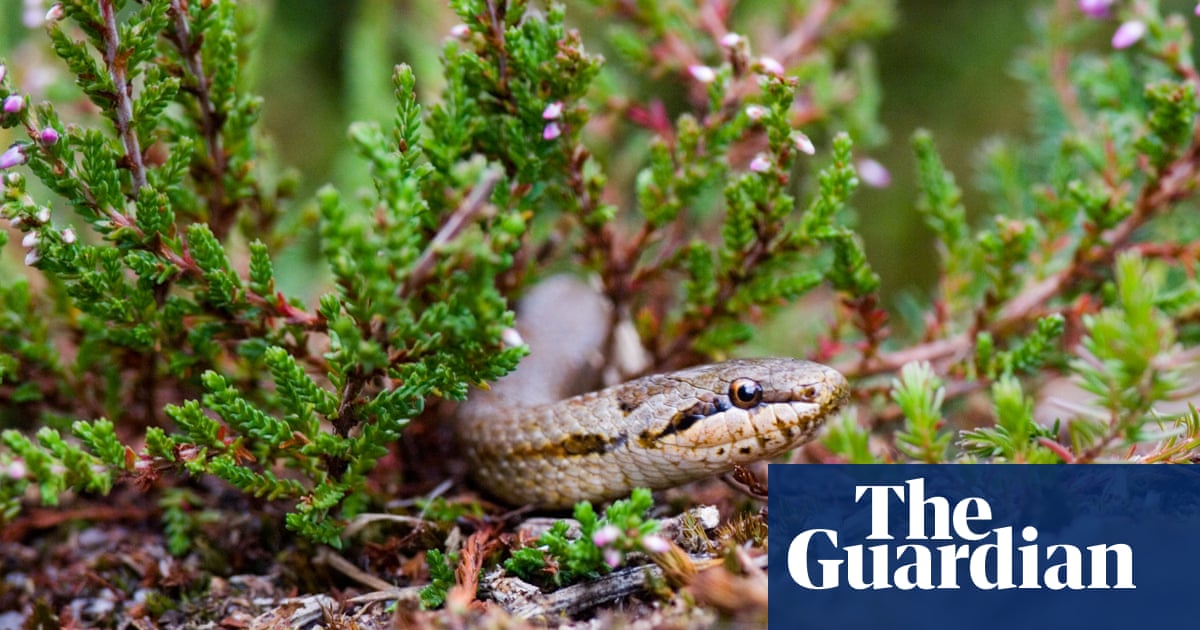It is a rich, complex landscape, a mosaic of heaths, woods, mires, reed beds, salt marsh and dunes that are home to a myriad of flora and fauna from rare birds, butterflies and bats to carnivorous plants.
Seven landowners have now joined forces to created what is being billed as the UK’s first “super national nature reserve” (NNR) on Purbeck Heaths in Dorset.
The idea is that by combining the disparate chunks of land, a more dynamic landscape easier to manage in a more natural way – and much simpler for wildlife to navigate through – will be created.
A stonechat, a bird the size of a robin with a call like two pebbles being hit together, provided the backing track as experts from the National Trust, RSPB and Natural England pointed out the features of the new super reserve from a vantage point high above the heathland on Tuesday.
“It really is a very special place,” said David Brown, a National Trust ecologist. He pointed out an area of bright gorse that is one of the few homes in this part of the world for the small pearl-bordered fritillary butterfly. “At the last count there were only 15 of them there. And they only stay in that one very small area.”
A major aim of the super reserve project is to help such creatures spread further so they do not rely on just one tiny area – and so face being wiped out if disaster strikes their home patch.
Ways in which this will be done include grazing the heathland with cattle and pigs and letting more human visitors tramp across. The concept is not about preserving the landscape as it is but to create the conditions in which it will change dynamically. It is as the changes are happening that some of the most interesting and rare species can flourish.
Some of the developments that will be made at Purbeck will be obvious such as removing non-native Scots pine. But other improvements will be much more subtle including simply encouraging bare patches that plants liked by the nationally scarce yellow centaury.
Brown is keen on the carnivorous plants that can do well here including the sundews. “You can sometimes see dragon fly wings floating on the surface of the boggy pools.The sundews digest their bodies and spit out the hard bits like the wings.”
Birds that do better here than in most places include the Dartford warbler, which dines on spiders that live in the gorse and the woodlark, another lover of tree-cleared ground.
The new Purbeck Heaths NNR knits together 11 types of priority habitat to enable wildlife to move more easily across the landscape. This will give wildlife, including the sand lizard and the Dartford warbler a better chance of adapting and thriving in light of the current climate crisis.
It combines three existing NNRs at Stoborough Heath, Hartland Moor, and Studland and Godlingston Heath. They will be linked with other nature reserves, conservation areas and a golf course, which manages its rough to encourage wildlife and plant life. The whole area will cover more than 8,000 acres and together they will create the largest lowland heathland NNR in the UK.
Partners also include the Forestry England, the private Rempstone Estate, Dorset Wildlife Trust and the Amphibian and Reptile Conservation Trust.
The chair of Natural England, Tony Juniper, said: “By creating bigger, better, and more joined-up wild places like this one, we will achieve big benefits for both people and wildlife.
“In facing the twin and deepening challenges of global heating and wildlife loss, we need to think and act on a larger scale. Today’s move marks a shift in gear and a new era for nature recovery in England.”
Purbeck Heaths is one of the most biodiverse places in the UK – home to thousands of species of wildlife, including 450 that are listed as rare, threatened or protected.
All six native reptiles are to be found here, including endangered smooth snakes and sand lizards. As well as the smaller birds such as the stonechat, raptors including hen harriers, marsh harriers, merlins, hobbies and ospreys, hunt the heathland.
At least 12 species of bats on the heaths. It is also one of the last strongholds for many specialist insects and other invertebrates, such as southern damselflies and the Purbeck mason wasp.
Mark Harold, the National Trust’s director of land & nature, said: “All the rare and beautiful wildlife living in and beyond the reserve will benefit hugely from a landscape where habitats are bigger, in better condition and better connected – and where natural processes are restored. Here they will be able to spread and build more resilient populations.”
Environment minister Rebecca Pow said it was a landmark project. “Purbeck Heaths is a trailblazing example of how landscape-scale conservation can help wildlife thrive, improve people’s well-being, and build resilience to climate change,” she said.
Source: Wildlife | The Guardian

